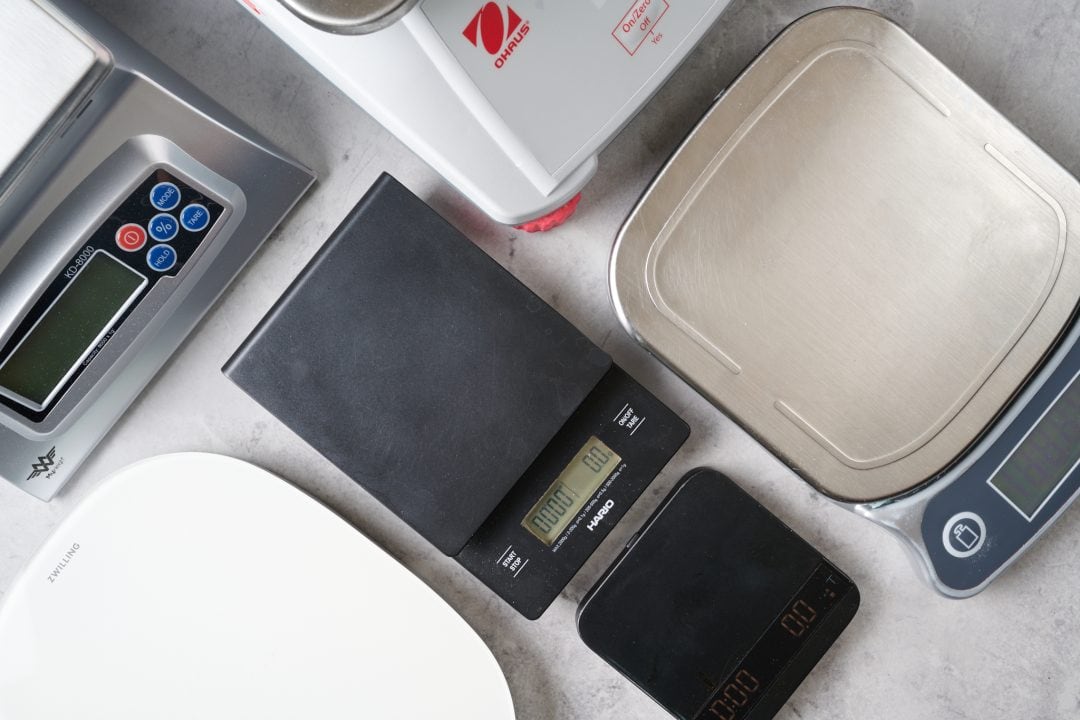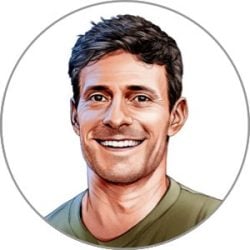A digital kitchen scale is the one piece of equipment I often say is mandatory for making sourdough bread. But, of course, it’s not strictly mandatory. People have been baking bread long before this invention, but because it helps make such significant strides toward accuracy and consistency (and efficiency!), it’s at the top of my best bread-making tools list. If you had to choose just one piece of equipment to buy, get a kitchen scale.
Occasionally, I’ll receive an email from a reader asking why this website doesn’t list measurements in volume in addition to weight. The fact is, weighing ingredients such as flour, salt, and sugar is much more accurate than measuring by volume with scoops and cups. Dry ingredients can be compacted during storage–and, conversely, they can also be “fluffed up” and aerated–and both situations make volume measurements wholly inaccurate.
…weighing ingredients such as flour, salt, and sugar is much more accurate than measuring by volume with scoops and cups.
In this post, I will go through what I consider the best kitchen scale for making sourdough bread and how I use the scale to make bread here at home, and I’ll also mention a few other scales I’ve tested over the past ten years that work well too.
Real Quick: The Best Kitchen Scale for Making Bread
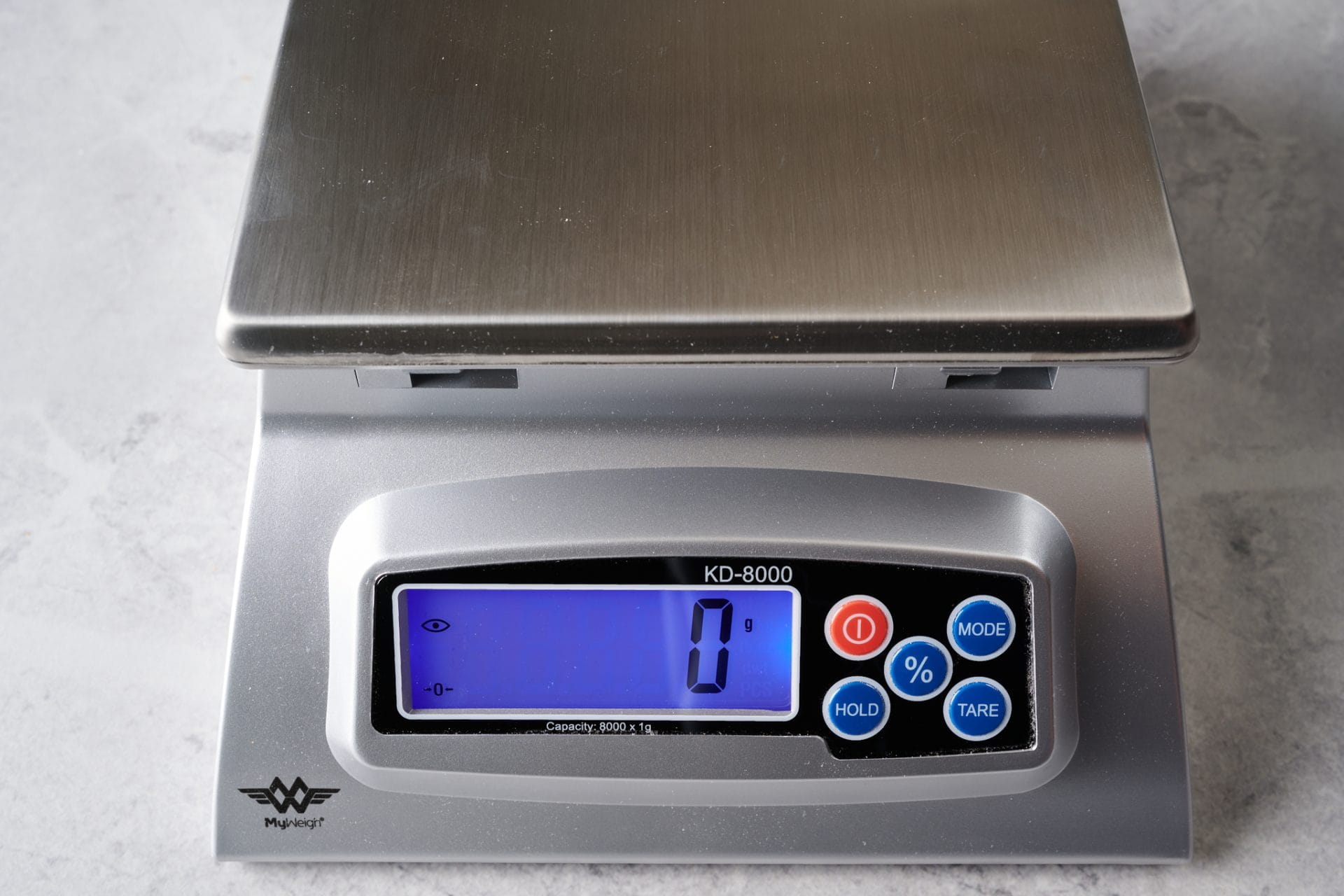
After using more than 15 scales over the past ten years, I consider the MyWeigh KD-8000 the best kitchen scale for making bread. It has all the features you’d want for measuring ingredients and is fast and accurate. I have used the MyWeigh KD-8000 digital kitchen scale for over ten years in my home kitchen and can wholeheartedly recommend it to any bread baker.
The MyWeigh KD-8000:
- Is fast and accurate
- Has a tare (zero) button
- Has a high weight capacity of 8 kilograms (17 pounds, 6 ounces)
- Can weigh in baker’s percentages
- Has an auto-off feature (which you can turn on and off)
- Has a removable top plate for easy cleaning
- Has a backlit LCD display
- Can be plugged in for continuous use
Why Should I Invest in a Quality Kitchen Scale?
Weighing ingredients, especially flour (and salt), is much more accurate by weight (in grams or ounces) than volume (cups or scoops). Flour can be scooped and compacted differently, resulting in inaccuracies dramatically affecting the amount of water needed to hydrate your dough. These inaccurate measurements lead to inconsistencies—something all bakers work hard to eliminate.
Consistent measurements lead to consistent results.
When you weigh ingredients with a scale, you can be sure the amount of each ingredient you’re weighing out today is the same as yesterday, regardless of how it’s scooped out of the bag or container. Consistent measurements lead to consistent results.
Additionally, weighing ingredients is much more efficient because you don’t have to scoop flour from a container, level the scoop, dump it into the mixing bowl, and repeat.
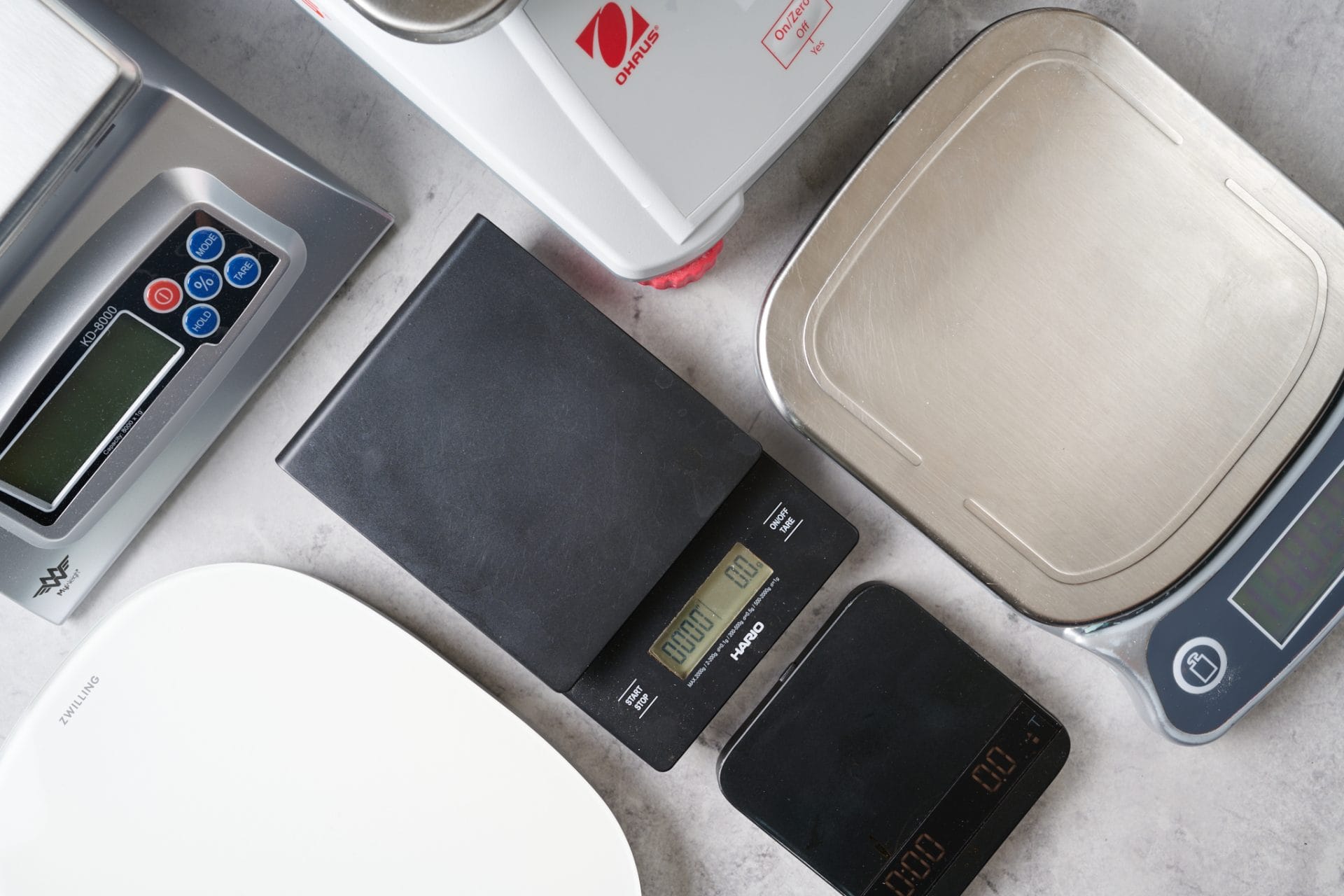
What I Look For in a Kitchen Scale for Making Bread
After countless hours using kitchen scales to make bread, I’ve settled on a checklist of what’s important. The kitchen scale should be:
- Accurate
- Fast
- Easy to read (even with a large mixing bowl resting on top)
- Easy to clean
- Have a high weighing capacity
- Have a tare (zero) function
- Durable
Many of these criteria are apparent, but perhaps not in the way you may think. Let’s look at a few of these points in more detail.
Scale Accuracy
Above all else, a kitchen scale needs to be accurate. I have a small calibration weight to ensure the weight I place on the scale is the weight it’s displaying. When I receive a scale, I first test it by placing the calibration weight in the center of the weighing plate, and then I move it to the corners to see how the scale performs if the item is off-center. Cheaper scales will only have one or two sensor points for weighing, meaning the scale will become inaccurate as the plate gets larger and the weight moves away from the sensor.
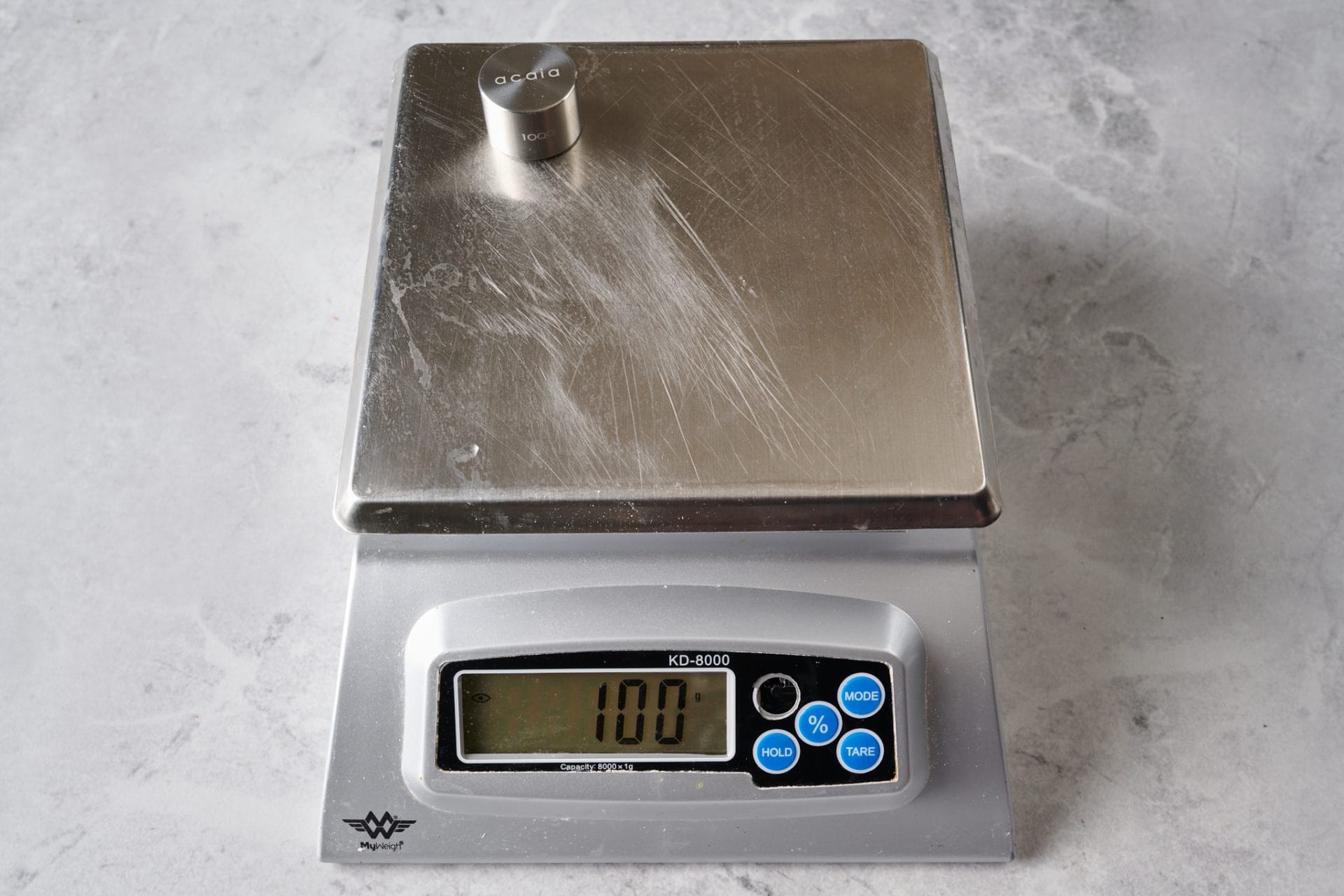
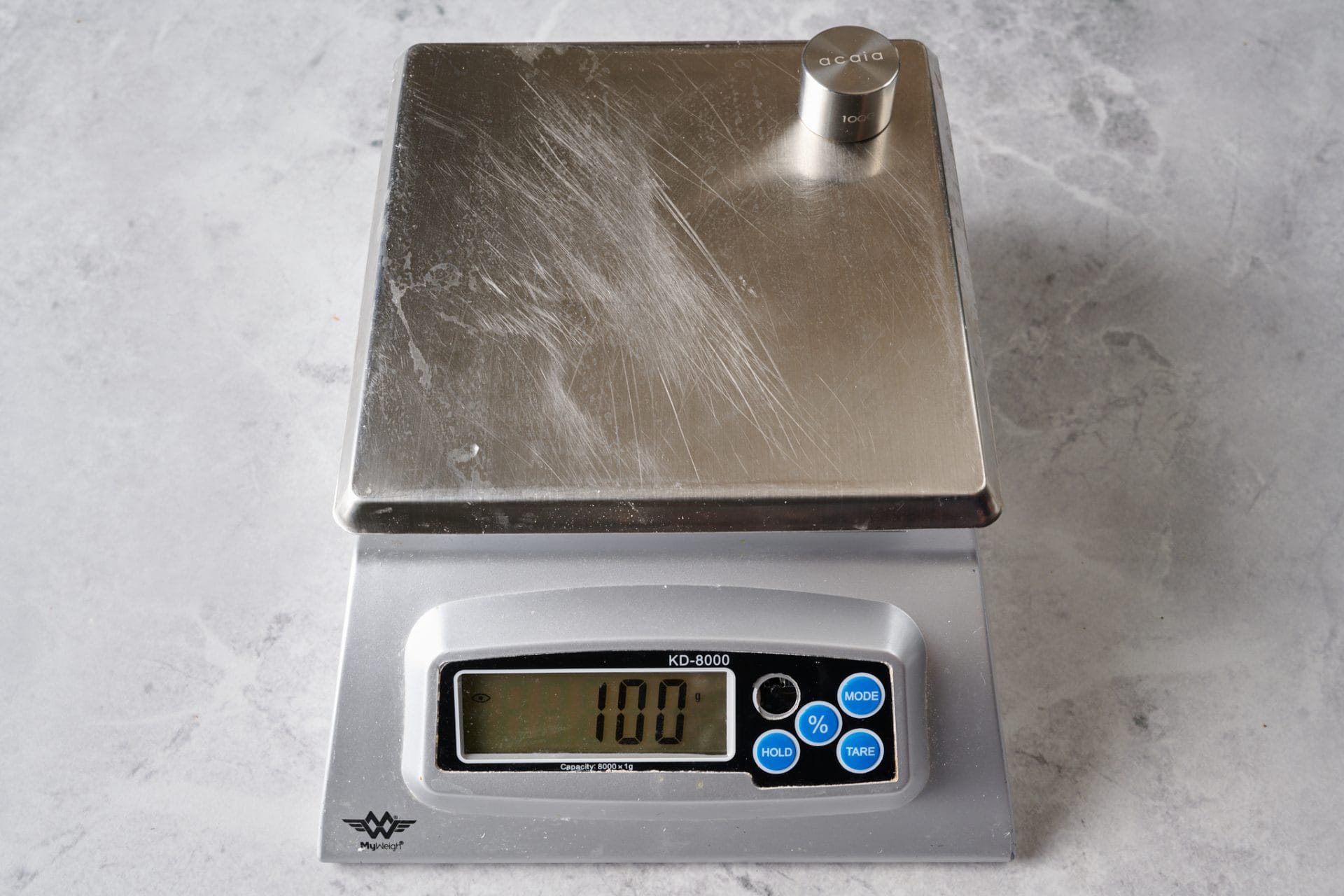
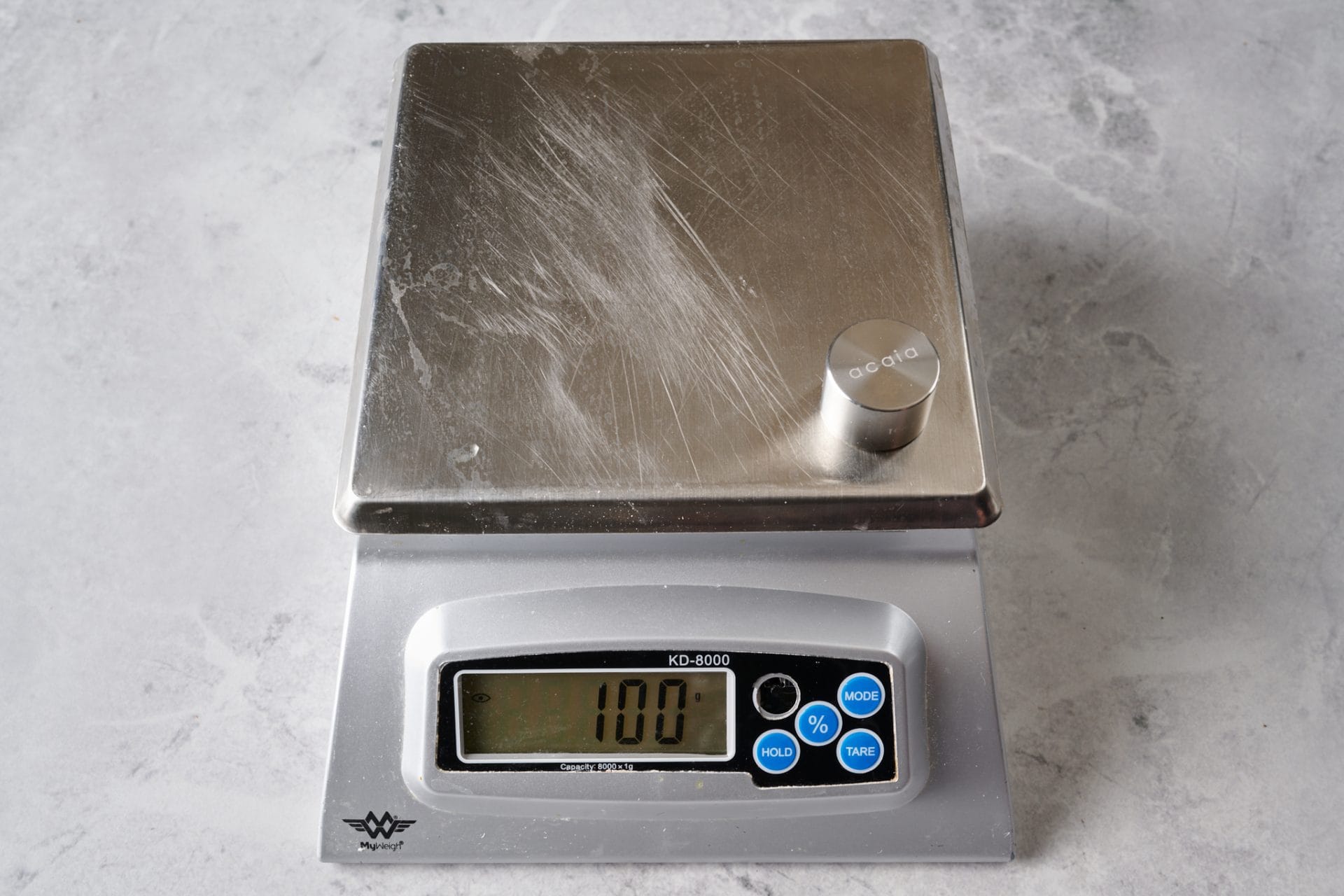
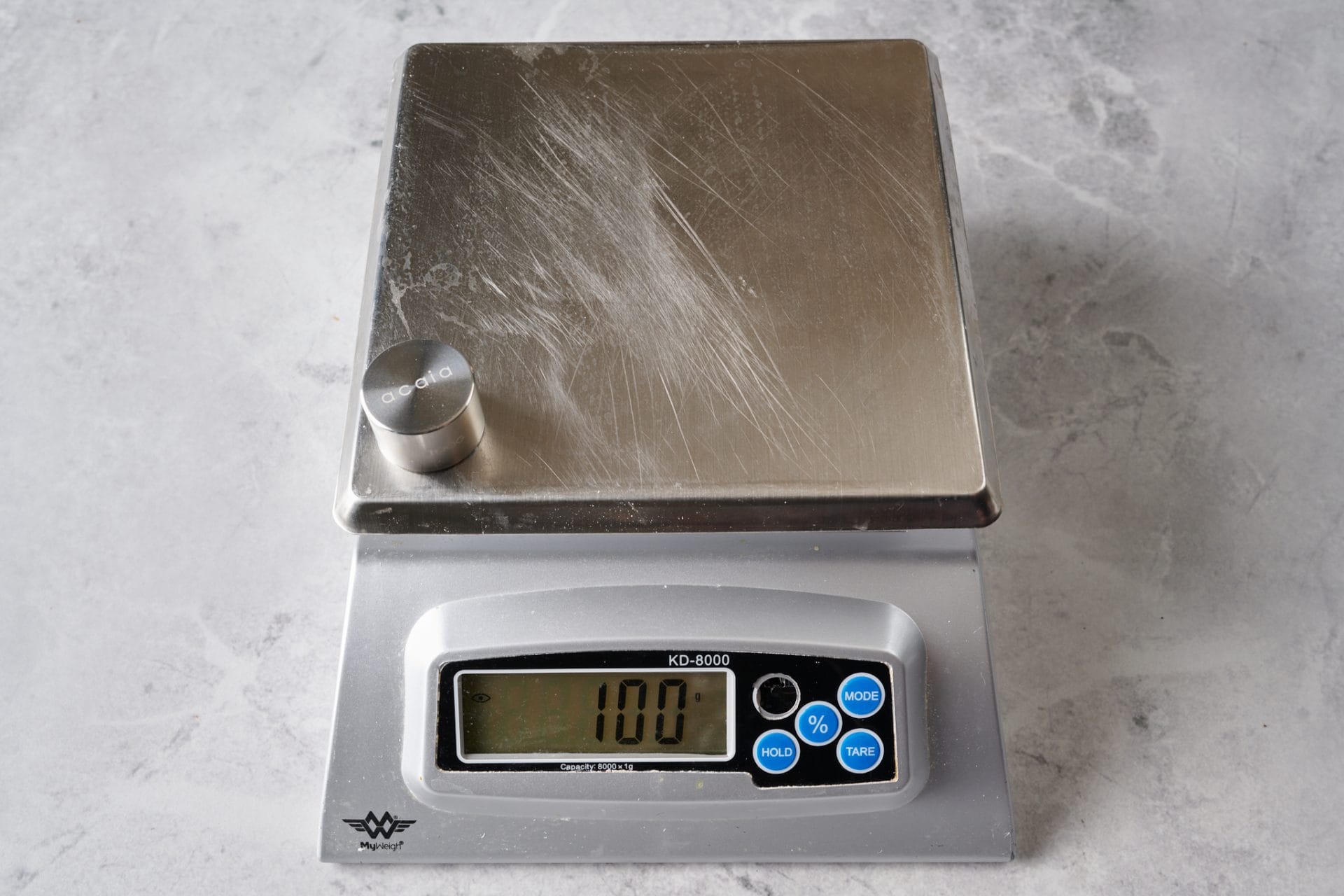
It’s also essential that a scale can accurately measure the weight of small ingredients, especially when they are added to a larger set of ingredients already on the scale. For instance, when you’ve added 2kg of flour to a bowl, and then have to add 20g of salt. This is a challenging test for most scales, and to always play it safe, I recommend measuring ingredients such as salt, diastatic malt powder, or other dried powders on the scale alone, then adding that to your larger bowl.
Fast Measurements
A scale should settle on its weight quickly. Cheaper scales sometimes will “seek” a weight and continuously change numbers as it’s settling on a result.
Easy to Read
The digital display for the scale should be easy to read in a myriad of conditions in the kitchen. This includes arguably the most encountered condition: a large mixing bowl on top can obscure the display on some scales.
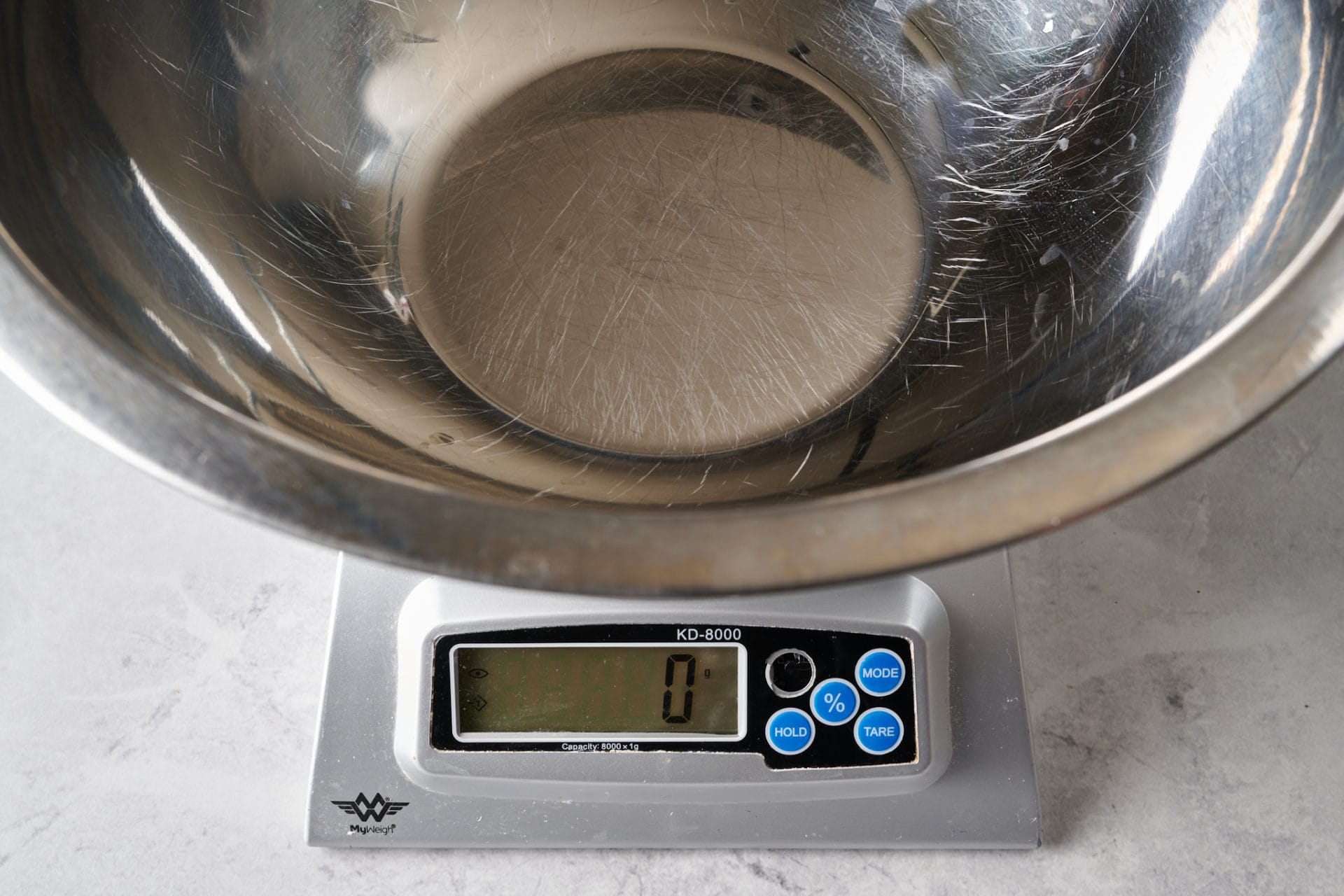
Durability
Bakers are known to be tough on their equipment–we are engaged in physical activity, after all. A kitchen scale should be able to hold up to prolonged use. The scale shouldn’t be so fragile that a bowl on top will scratch the surface (I’m looking at you, glass scales).
Easy to Clean
Let’s start by saying that baking sourdough bread at home is messy. Embrace the messiness. Just be sure the scale you’re using can as well. A scale should allow easy removal of the weighing plate to make cleaning any dough, water, or other ingredients off of it easy.
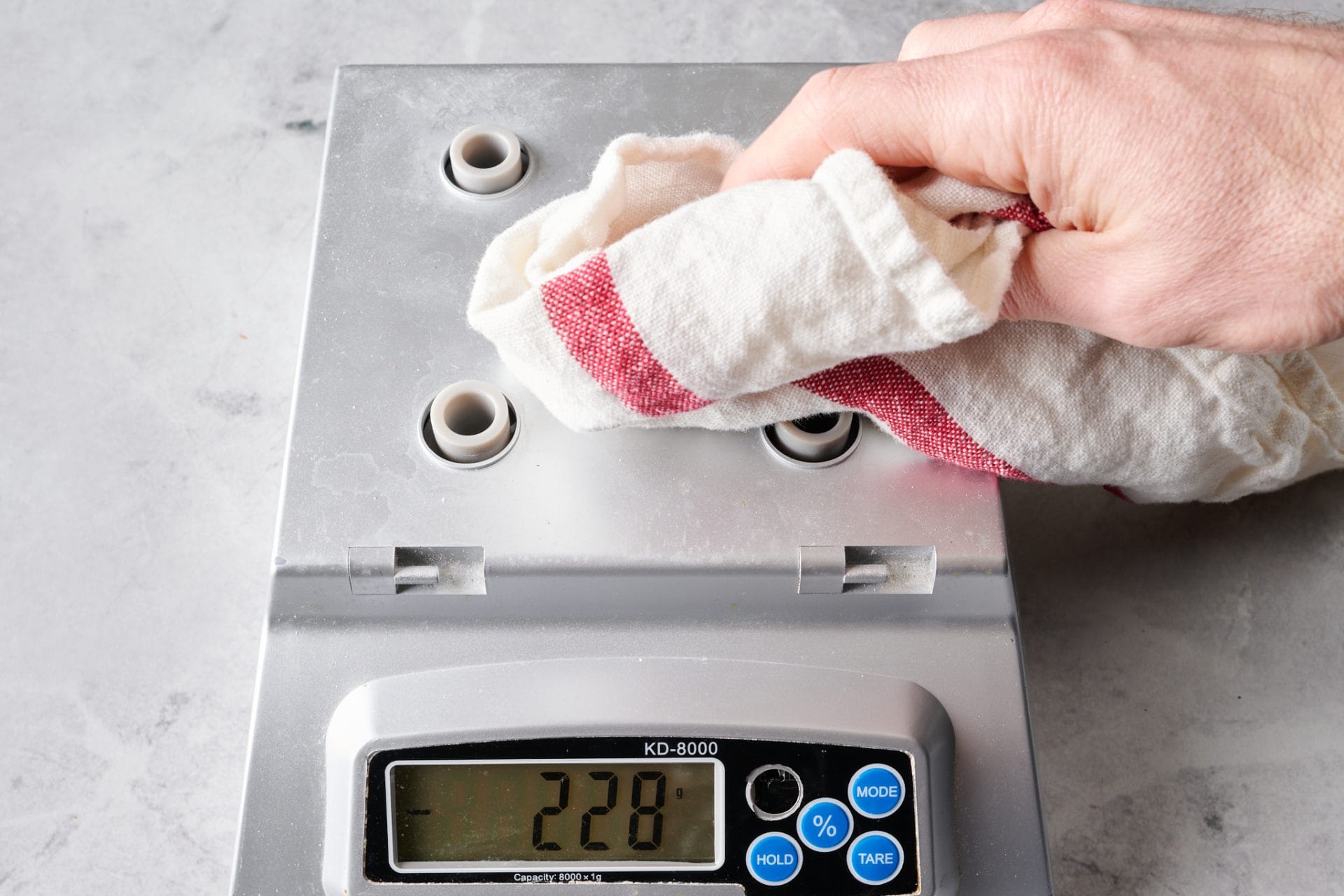
Digital Versus Mechanical Kitchen Scales
In the early days of my baking, I used a purely mechanical scale for weighing. These older scales certainly do have a certain charm to them. As a kid, I remember watching my dad quickly divide and weigh pieces of pizza dough on his large mechanical scale. The weighing needle would snap and clack from zero to his desired weight as he tossed each piece of dough onto the plate, waited several seconds for the needle to settle, then the next worker would snatch the dough and ball the pizza dough.
However, mechanical scales can be slow and hard to read, especially if the weighing needle obscures the measurement readout on the front of the scale. While I value that sourdough breadmaking forces us to slow down and enjoy the process, waiting for a scale to settle is not part of that enjoyment. For these reasons, I prefer using a digital scale to quickly weigh ingredients and dough when making bread.
The Best Kitchen Scale for Making Bread: MyWeigh KD-8000
After more than ten years of using a variety of scales, I’ve found the MyWeigh KD-8000 to be the best kitchen scale for making bread, especially for the home baker. The MyWeigh has all the features a baker could need and is easy to use, accurate, easy to clean, fast, and cost-effective.
A few specifications for the MyWeigh KD-8000 baking scale:
- It runs on 3 AA batteries for a long time but can also use an AC adapter for continual operation
- It is precise to 1 gram
- Has an adjustable auto-off feature
- Has a tare button to zero the scale with an item on top
- Is extremely durable and long-lasting
- The weighing plate (platform) is large enough for most bread tasks
- Has a maximum weighing capacity of 8000 grams (8kg), which is plenty for most home bakers
The MyWeigh scale has all the features a bread baker would want, without any gimmicky add-ons or user interface quirks that ruin many scales available today.
Finally, the MyWeigh is at the right price point for a scale that will easily last a decade (as mine has) with daily use in the kitchen. My scale has lasted through countless bakes, and I use it at least twice a day, every day, to feed my sourdough starter.
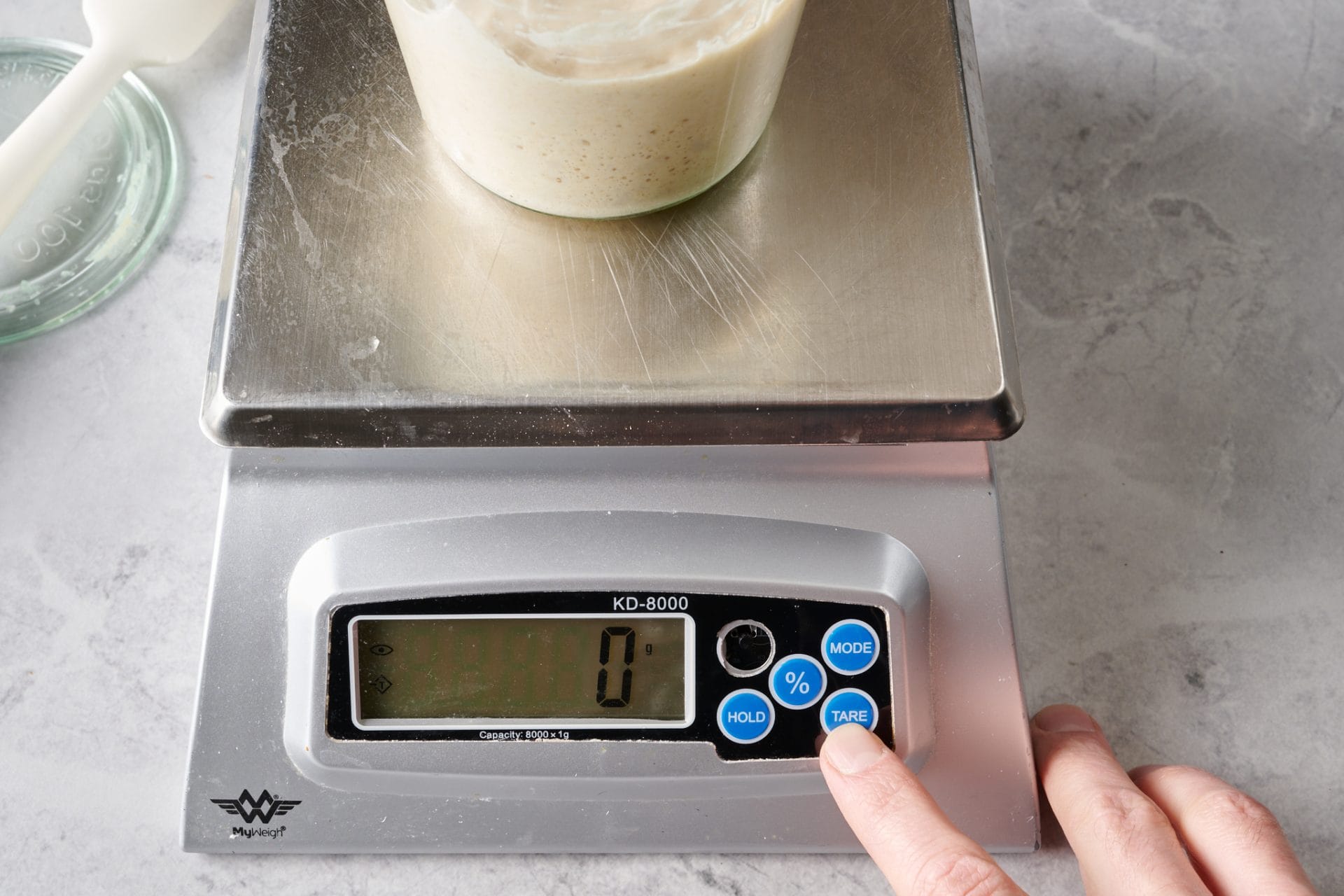
Above, you can see a picture of the exact scale I purchased in 2013, and as you can see, it’s held up incredibly well despite its continued use. The most common point of failure for this scale is that the button cover wears off after a while, as mine has, but it still works fine. If this does happen to you, a little electrical tape cut to fit will solve the problem.
How to Use the MyWeigh KD-8000 Digital Kitchen Scale
You can find several functions below in the official online MyWeigh manual, but a few others, like how to disable the auto-off feature, are surprisingly not in the user manual.
How To Disable the Auto-Off Feature
The scale will turn itself off after a few minutes of no interaction. This feature is handy if you often forget to turn off your scale, but it can be annoying if it turns off while you’re mixing bread dough and need it to be on continuously.
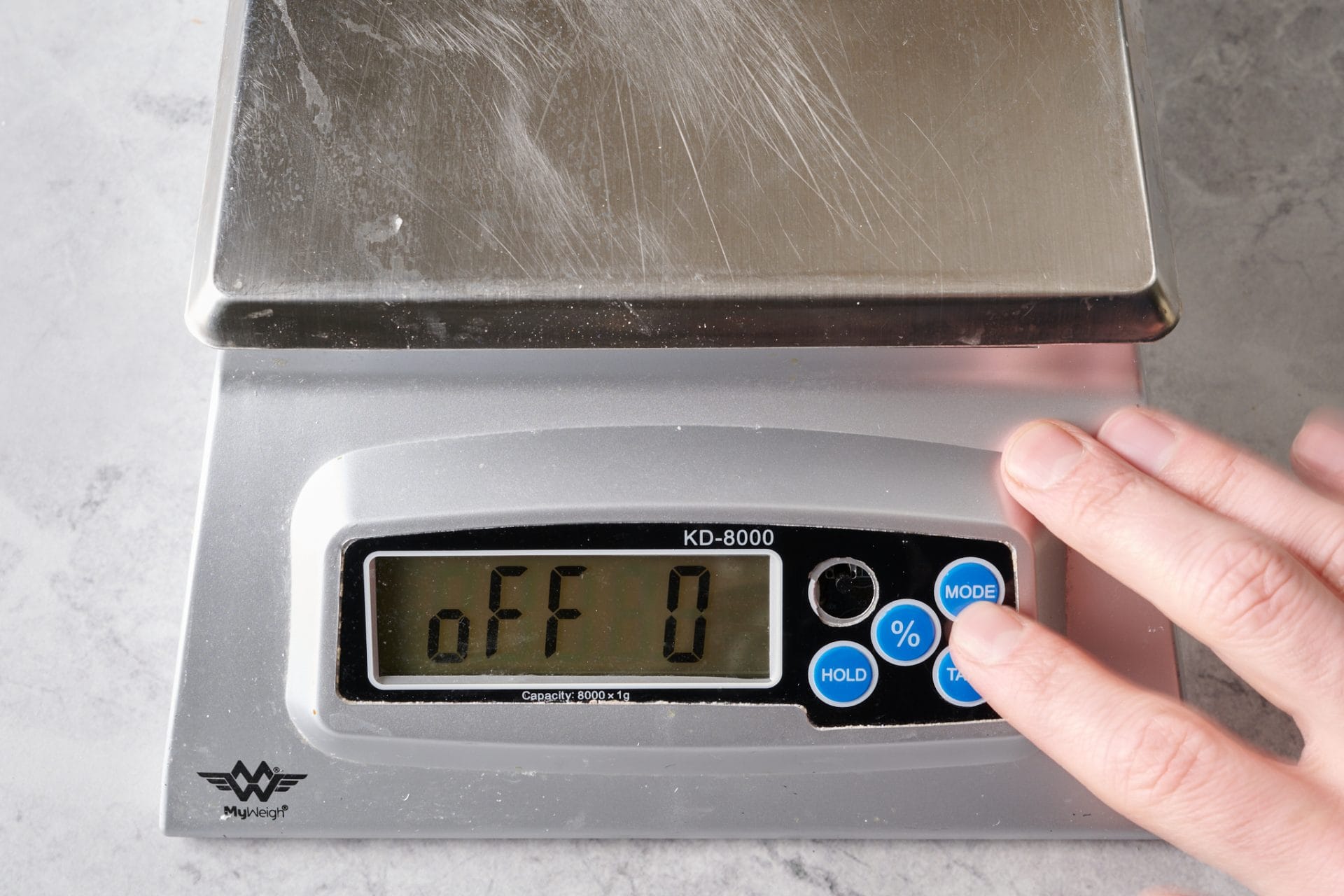
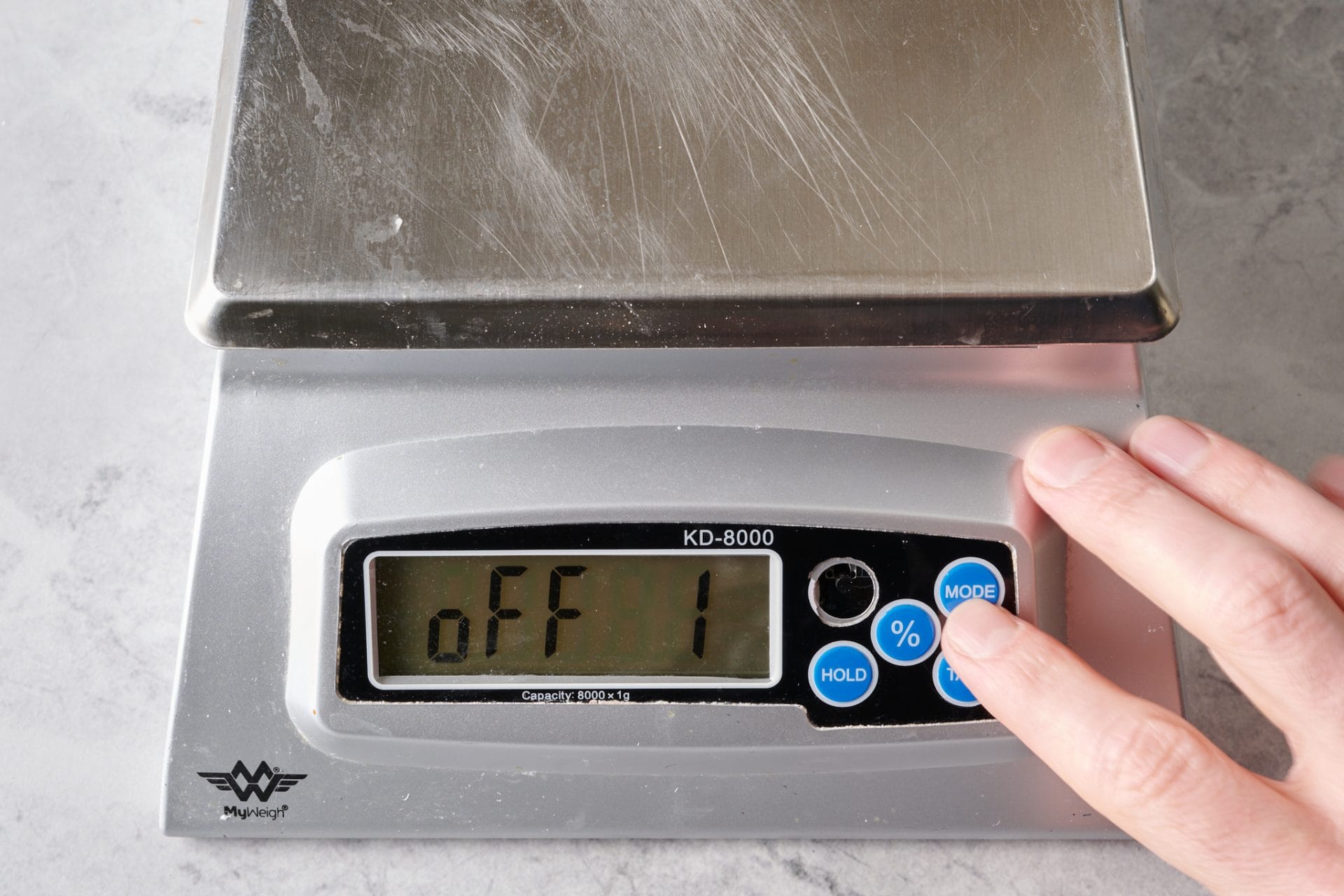
To disable the auto-off feature:
- Turn the scale off.
- Press and hold the HOLD button, then press and hold the POWER button. Hold these buttons for about 5 seconds as the scale does a visual countdown.
- “nb 0” will be displayed (this is the weighing response speed). Press the TARE button.
- “off” will be displayed. Press the MODE button to enable or disable the auto-off feature:
- “off 0” – auto-off disabled (the scale will not turn off automatically)
- “off 1” – auto-off enabled (the scale will turn off automatically after a couple of minutes)
- Press TARE to save the setting change.
How To Turn On and Off the Backlight
Toggle the small switch at the back of the scale to turn on and off the backlight feature.
How To Calibrate The MyWeigh KD-8000 Scale
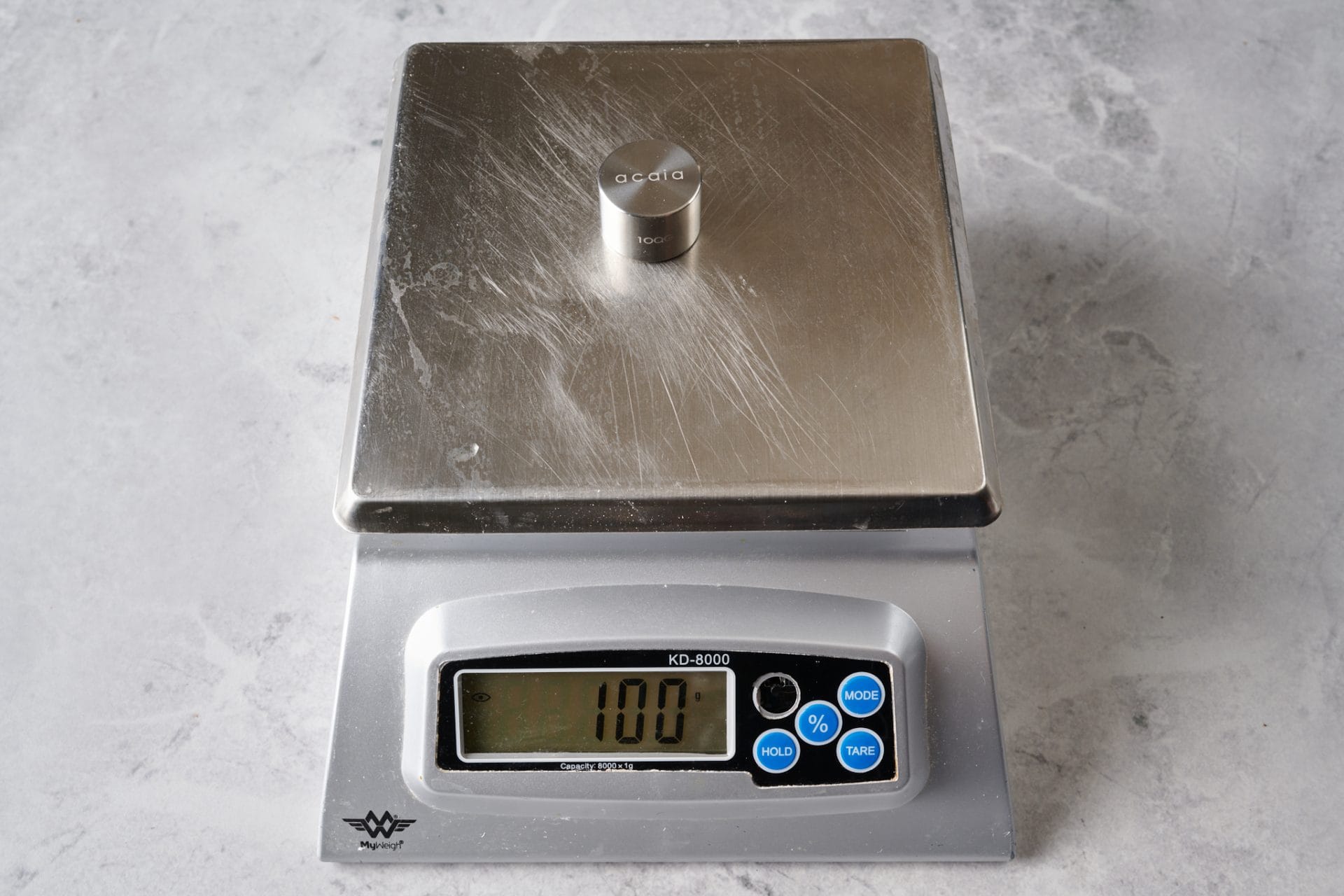
Calibration can help ensure your scale measures the correct weight. If the scale is moved from locations with drastically different altitudes, it can help to recalibrate. To calibrate the MyWeigh kitchen scale, you must have a 5kg calibration weight (or a combination of weights known to weigh 5kg).
- Starting with the scale off, press and hold the MODE and POWER buttons simultaneously, release both buttons, and wait for the display to show CALE.
- Place a 5kg weight on the platform. Wait 5 seconds, then press TARE. The scale will show PASS when successful.
- Turn the scale off. It’s now calibrated and ready for use.
How To Use Baker’s Percentages On The MyWeigh Scale
One handy feature of the MyWeigh scale is its baker’s percentage weighing feature. Ingredients placed on the scale can be displayed as a percentage of the total flour weight instead of their individual weights.
Baker’s percentages allow for recipes to be easily scaled up and down, and all percentages are calculated based on the total flour of a recipe, which is always 100%. See my guide to baker’s percentages to take advantage of this feature.
How to use the Baker’s Percentage weighing feature:
- Place a mixing bowl on the weighing plate and press TARE
- Add all the flour in the recipe to the mixing bowl and wait for the eye symbol to appear (meaning the scale has stabilized)
- Press the % button
- Remove the bowl (the scale should display 0%)
- Add the next ingredient and continue to add it until the percentage shows your desired amount (for example, add water until the percentage shows 80% for a dough with 80% hydration
- Remove the ingredient and repeat for any remaining ingredients
- When finished weighing, press TARE to clear the scale
What If I Need to Weigh Something Less Than 1 gram (Like Salt)?
One challenge with most kitchen scales is their precision. Most only read whole-gram measurements and will not read weights less than 1 gram. This can present a problem when working with small batches of bread dough or when weighing ingredients such as salt or diastatic malt powder because these low weights often need sub-gram precision.
Salt, malt powder, and instant yeast are ingredients that might call for 0.1-gram precision. If you’re working in baker’s percentages and your spreadsheet (like my TPL Member’s spreadsheets) says to add 12.7g of salt, you need to round up to 13g or use a fine-precision scale to measure 12.7g of salt accurately. If you round up to 13g, it will mean your bread dough has a higher salt percentage than your formula specifies.
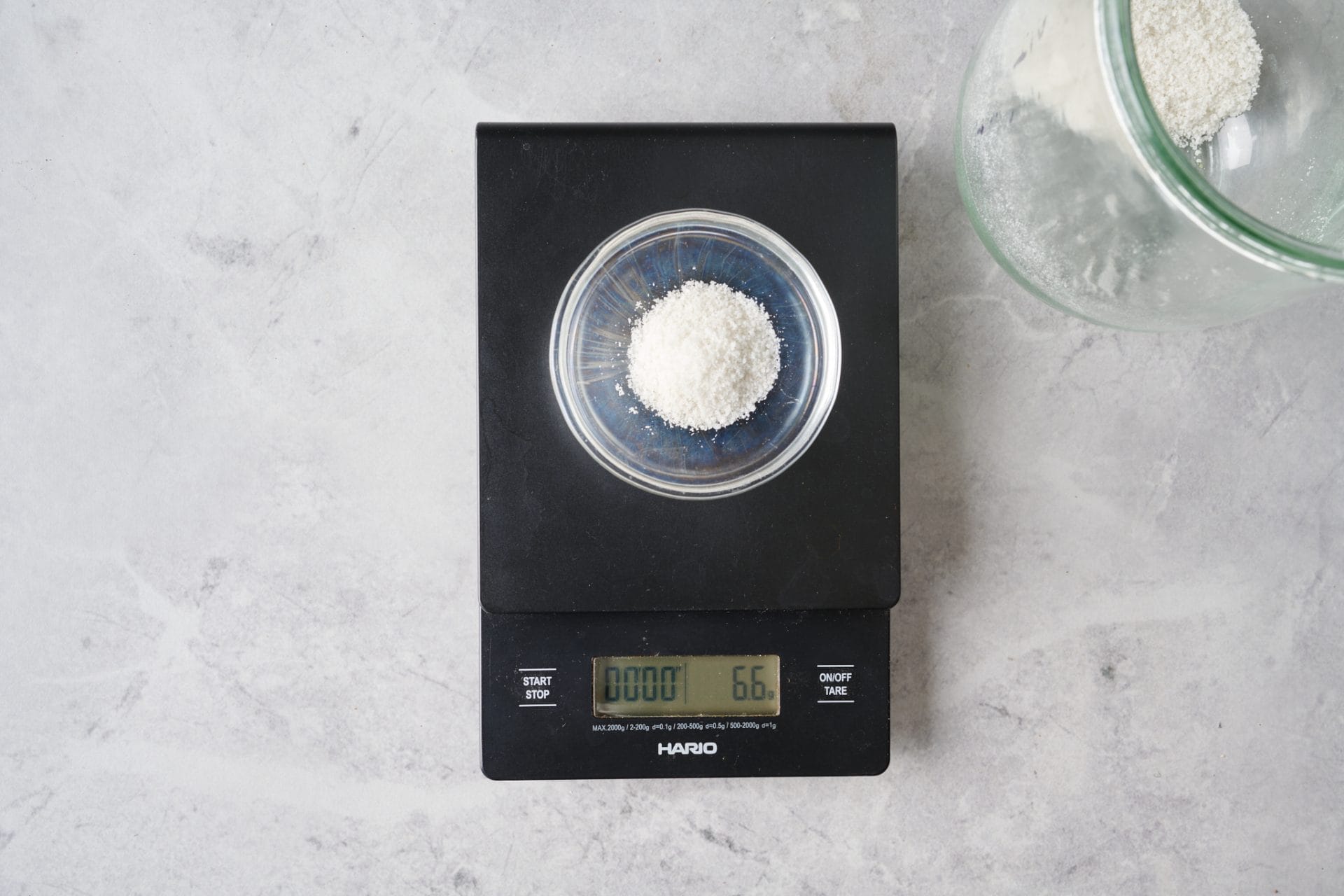
A small jeweler’s scale or coffee scale, like my Hario V60 coffee scale, can weigh ingredients that need sub-gram precision.
When measuring salt, clear the weighing plate and place a small dish on the plate. Tare the scale, then pour the salt into the dish. Measuring a relatively minimal ingredient like this on the scale alone is more accurate than having a large mixing bowl filled with heavy flour on the scale, then add the salt to that for measuring.
For recipes here at The Perfect Loaf, I typically make things easier by listing the salt weight in whole numbers since many people do not have a scale that will measure 0.1-gram precision.
Ultimately, it depends on how rigorous you want to be with your salt and malt measurements. If you want to be the most precise, use a jeweler’s or coffee scale to measure these two ingredients, then use a larger scale like the MyWeigh to weigh everything else.
Size Of MyWeigh KD-8000 Weighing Plate (Weighing Platform)
An essential aspect of any baking scale is the size of the weighing tray (where you place your ingredients or dough on top of it for weighing). The MyWeigh scale has a removable stainless steel tray that’s 6 ½ by 6 ½-inches. This tray is large enough for most weighing purposes, even when dividing and preshaping bread dough.
What If I Need a Larger Scale?
In some cases, bakers need a larger scale with a larger weighing plate. When weighing larger pieces of dough (like miche dough or even my typical 900-gram batard), I turn to my scale by Ohaus, a company that produces some of the best weighing instruments, though they are expensive.
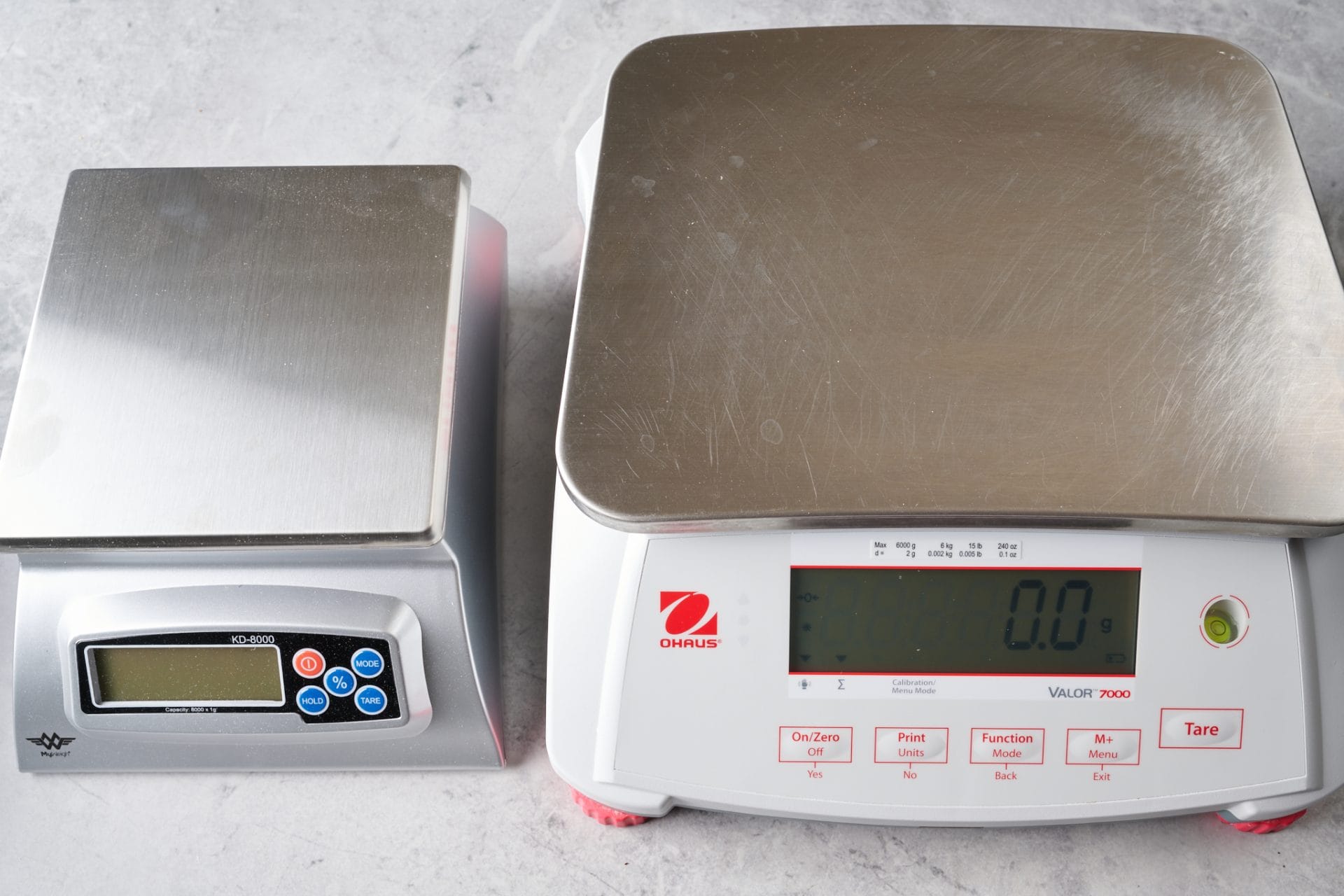
Several years ago, I purchased the Ohaus Vaolr V71P6T, a compact and portable bench scale capable of weighing 6000 grams (6kg). While the max capacity of this scale is not as high as the MyWeigh, the extensive weighing surface and rock-solid accuracy are fantastic. I also appreciate that it has a rechargeable internal battery and can run on AC power, and it also has a rear LCD display so multiple bakers can use the scale simultaneously.
If you’re looking for a larger weighing surface or a scale that many bakers can use simultaneously (the scale has a display on the front and the back), the Ohaus V71P6T is my pick.
What Other Kitchen Scales Have I Tried?
In search of the best kitchen scale for making bread, I’ve tried numerous models. Here’s a short list of the other scales I’ve tried:
- Oxo Good Grips. I enjoyed this Oxo scale and think it’s a good alternative to the MyWeigh. It has a nifty pull-out display for when you have large bowls on top.
- Zwilling Enfinigy Digital Kitchen Food Scale. I love that this scale has a rechargeable battery—all scales should have this (the Ohaus I talked about previously does as well!). In the end, I don’t like the glass surface, the touch interface can be tricky when your hands are covered in dough, and it turns off automatically after too short a period.
- EatSmart ESKS-10 Precision Elite Digital Scale. This very cost-effective scale is light, thin, relatively durable, and has most of the functions a baker would want (though it does not have a baker’s percentage feature). Ultimately, I didn’t choose this scale as the best because it is slow to settle on a measurement and felt a little cheap.
- Ozeri Touch Professional Digital Kitchen Scale. I purchased this scale early in my baking and did not keep it. The glass surface is strange to weigh on (especially when weighing pieces of dough), I did not like the touch interface (versus physical buttons), and it took too long to stabilize a measurement. It was also not very accurate.
Kitchen Scale FAQs
What is the best scale for baking?
After using it (and testing many others) for over ten years, I’ve found the best kitchen scale for making bread is the MyWeigh KD-8000.
Why Should You Measure by Weight When Making Bread?
Measuring your ingredients for making bread by weight instead of volume is the most accurate method since it ensures you use the same amount of flour each time you mix. Additionally, measuring by weight and using baker’s percentages simplifies scaling up and down recipes to make more or less bread.
How do I clean a kitchen scale?
Remove the weighing plate and wipe any spilled ingredients with a damp towel. Be careful not to get water or place anything into the holes where the weighing plate sits to avoid damaging the sensors.
How big is the weighing plate for the MyWeigh KD-8000?
The stainless steel weighing plate (surface) is 6 ½” by 6 ½” (165mm x 165mm).
What does tare do on a scale?
Pressing the tare button will zero the scale. For instance, if you place an empty bowl on the scale and press tare, the scale will now read 0, so the bowl’s weight is not measured. This is helpful if you want to weigh the ingredients you’re adding to the bowl but not include the bowl’s weight.
What’s Next?
With the best kitchen scale for making bread, next, let’s talk about your sourdough starter jar. Does the one you have make daily feedings hassle-free? If not (or if you’re just curious), check out my favorite jar for holding a sourdough starter.


